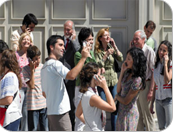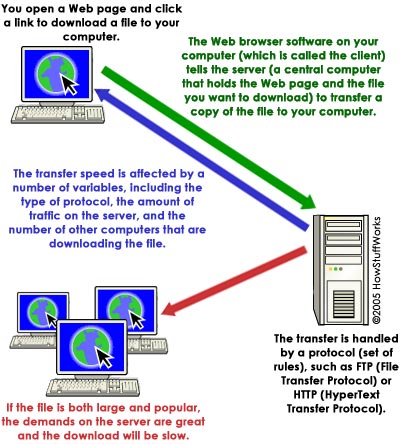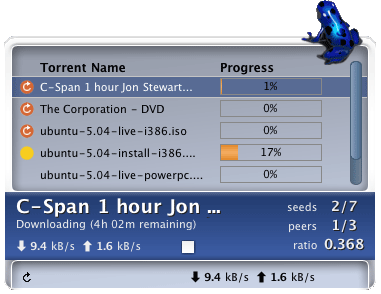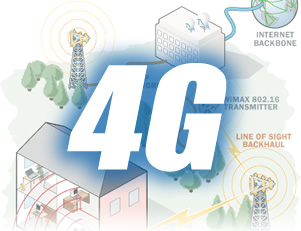|
IMPLEMENTING SAAS - A CASE STUDY

Organization:
Standing regally in the heart of Calcutta’s Park Street, the Oxford Bookstore has been a haven for book lovers and intellectuals since the 1920’s. A part of Rs 1,500-crore Apeejay Surrendra Group, the iconic bookstore celebrates 90 years in 2010 (it also marks the centenary year of the group).
read more... |
How Safe are Cell Phones?

Cell phones are almost as common as pocket change these days. It seems nearly everyone, including an increasing number of children, carries a cell phone wherever they go. Cell phones are now so popular and convenient that they are surpassing landlines as the primary form of telecommunication for many people.
read more...
|
|
|
BitTorrent

BitTorrent is a protocol designed for transferring files. It is peer-to-peer in nature, as users connect to each other directly to send and receive portions of the file. However, there is a central server (called a tracker) which coordinates the action of all such peers. The tracker only manages connections, it does not have any knowledge of the contents of the files being distributed, and therefore a large number of users can be supported with relatively limited tracker bandwidth. read more...
|
|
|
4G Wireless Systems

Fourth generation wireless system is a packet switched wireless system with wide area coverage and high throughput. It is designed to be cost effective and to provide high spectral efficiency . The 4g wireless uses Orthogonal Frequency Division Multiplexing (OFDM), Ultra Wide Radio Band (UWB),and Millimeter wireless.
read more...
|
Punctuality

Punctuality is the characteristic of being able to complete a required task or fulfill an obligation before or at a previously designated time."Punctual" is often used synonymously with "on time."Punctual can also,when talking about grammar, mean to be accurate.
read more...
|
| |
|
Detailed Articles |
|
IMPLEMENTING SAAS - A CASE STUDY
But things weren’t always this good. When Subhasish Saha, CTO, Apeejay Group, joined in April 2008, the bookstore’s IT infrastructure suffered from serious challenges. “There were significant inefficiencies with the point of sale function. And since the inventory management system was not integrated with the POS system, we lacked control over our inventory,” he says.
Business case:

That’s something the Oxford Bookstore's head of finance and accounts, Anindya Subhro Biswas, has seen the bookstore battle for a long time. “Traditionally, the book retailing business has been prone to excess purchases, an over-stocking of SKUs, and a pile-up of non-moving or slow-moving inventory.”
It’s a problem that all Indian book retailers without IT systems face, given that India produces over 80,000 new titles a year.
Oxford, for example, adds about 50,000 new titles a year to the 2 lakh it already maintains. What made it harder for Oxford was its decentralized approach. This allowed a single title to have multiple codes across each of Oxford’s 25-plus stores, making it almost impossible to get a fix on the number of copies it had of a popular title like, say, Shantaram. Inevitably, this led to high inventories. “With a dispersed retail operation and increased volume of transactions, the challenge was to find a way to regulate processes and manage transactions,” says Biswas. And with over 150 additional SKUs a day, Oxford’s problem wasn’t getting smaller. Despite these challenges, Saha’s bosses in Kolkata gave him a tall order. “We wanted to encash on an early-mover advantage by rapidly expanding our retail operation, both in India and abroad,” says Biswas. “The vision was to operate over 100 bookstores by 2010, the eve of centenary of the Apeejay Surrendra Group.”
Project:
If the iconic bookstore was going to meet that target, it needed visibility along its entire supply chain, from its supplier to down to its stores — the sort of visibility that an ERP system could provide. The problem was that an SME like the Rs 25-crore Oxford Bookstore didn’t have the deep pockets an ERP implementation called for. It’s a growing problem for India with SMEs upping their contribution to the country’s GDP from 17 percent to 22 percent by 2012, according to Assocham.
“Management was looking for a model that would allow Oxford Bookstore to leverage its full IT potential without large one-time IT capital investments or issues of scalability,” says Saha.
Theoretically, that’s exactly what a SaaS model offers. And although some solution providers have tested it with industries like apparel, admittedly, the idea remains unconventional in India — and it had almost never been tried in Indian retail before.
Challenges:

Also, few providers offered the complete set of services Saha wanted and there was no guarantee that once a deal had been inked Saha’s small account wouldn’t get jostled aside by larger ones. At the same time, Oxford’s management was apprehensive about using a SaaS model because it had heard about security challenges, and had fears about vendor lock-in.
Most of these issues could be dealt with, if Saha could find the right vendor and more research and relationship later, he did. “We decided on a vendor only after we were sure they would not just be an implementer but a fully-involved business partner,” says Saha. “Now, we have one of the very few full-cycle implementations of SAP IS retail delivered via a SaaS model and we’re a first-of-its-kind in the book retail industry.”
Benefits:
Today, the ERP-SaaS project has centralized all Oxford titles across all branches into a single directory controlled by an ERP. Data from here flows to all modules including a store inventory module and the bookstore’s points of sale. It also covers the company’s payroll and accounting needs, and Web tools, says Saha. The results of the Rs 1.08-crore ERP-SaaS project (which is to be paid in monthly installments over five years) is the best gift Oxford could have asked for. Revenues have catapulted a full 20 percent adding a whopping Rs 3.4 crore to the bookstore’s coffers.
The ERP-SaaS project also helped increase footfalls into Oxford’s bookstores by 25 percent and swell bill sizes by 20 percent. Profits have been spectacular on the e-platform too. Online sales have jumped a full 100 percent and revenues have escalated by 50 percent. It’s also made other aspects of running a retail business easier, including managing a CRM, a loyalty program and discount schemes. “We have optimized our merchandising mix, reduced the carrying cost of inventory, and increased our monitoring on non-moving and slowmoving inventory. Also we have managed to regulate discounts and credit limits,” says Biswas. Saha estimates that Oxford will recover the cost of the ERP-SaaS implementation in four years.
Article Source
|
|
|
How Safe are Cell Phones?
Long-term cell phone use may pose health risks
Is Growing Cell-Phone Use Increasing Health Risks?

In 2008, for the first time, Americans are expected to spend more on cell phones than on landlines, according to the U.S. Labor Department. And we not only love our cell phones, we use them: Americans racked up more than a trillion cell-phone minutes in the first half of 2007 alone.Yet, as cell-phone use continues to grow, so does concern about the possible health risks of prolonged exposure to cell-phone radiation.
Do Cell Phones Cause Cancer?

Wireless cell phones transmit signals via radio frequency (RF), the same kind of low-frequency radiation used in microwave ovens and AM/FM radios. Scientists have known for years that large doses of high-frequency radiation—the kind used in X-rays—causes cancer, but less is understood about the risks of low-frequency radiation.
Studies on the health risks of cell-phone use have produced mixed results, but scientists and medical experts warn that people should not assume no risk exists. Cell phones have been widely available for only the past 10 years or so, but tumors may take twice that long to develop.
Because cell phones haven’t been around very long, scientists haven’t been able to assess the effects of long-term cell-phone use, or to study the effects of low-frequency radiation on growing children. Most studies have focused on people who have been using cell phones for three to five years, but some studies have indicated that using a cell phone an hour a day for 10 years or more can significantly increase the risk of developing a rare brain tumor.
What Makes Cell Phones Potentially Dangerous?

Most RF from cell phones comes from the antenna, which sends signals to the nearest base station. The farther the cell phone is from the nearest base station, the more radiation it requires to send the signal and make the connection. As a result, scientists theorize that the health risks from cell-phone radiation would be greater for people who live and work where base stations are farther away or fewer in number—and research is beginning to support that theory.
In December 2007, Israeli researchers reported in the American Journal of Epidemiology that long-term cell-phone users who live in rural areas face a "consistently elevated risk" of developing tumors in the parotid gland compared with users who live in urban or suburban locations. The parotid gland is a salivary gland located just below a person’s ear.And in January 2008, the French Health Ministry issued a warning against excessive cell phone use, especially by children, despite the lack of conclusive scientific evidence linking cell-phone use with cancer or other serious health effects. In a public statement, the ministry said: "As the hypothesis of a risk cannot be entirely excluded, precaution is justified."
How to Protect Yourself from Cell-Phone Radiation

“Precaution” seems to be the approach recommended by an increasing number of scientists, medical experts and public health agencies, from the French Health Ministry to the U.S. Food and Drug Administration (FDA). General recommendations to minimize the potential health risks include talking on cell phones only when necessary, and using a hands-free device to keep the cell phone away from your head.
If you’re concerned about your exposure to cell-phone radiation, the Federal Communications Commission (FCC) requires manufacturers to report the relative amount of RF absorbed into a user’s head (known as the specific absorption rate, or SAR) from every type of cell phone on the market today. To learn more about SAR and to check the specific absorption rate for your phone, check the FCC website.
Article Source
|
|
|
BitTorrent
The key philosophy of BitTorrent is that users should upload (transmit outbound) at the same time they are downloading (receiving inbound.) In this manner, network bandwidth is utilized as efficiently as possible. BitTorrent is designed to work better as the number of people interested in a certain file increases, in contrast to other file transfer protocols.

One analogy to describe this process might be to visualize a group of people sitting at a table. Each person at the table can both talk and listen to any other person at the table. These people are each trying to get a complete copy of a book. Person A announces that he has pages 1-10, 23, 42-50, and 75. Persons C, D, and E are each missing some of those pages that A has, and so they coordinate such that A gives them each copies of the pages he has that they are missing. Person B then announces that she has pages 11-22, 31-37, and 63-70. Persons A, D, and E tell B they would like some of her pages, so she gives them copies of the pages that she has.
The process continues around the table until everyone has announced what they have. The people at the table coordinate to swap parts of this book until everyone has everything. There is also another person at the table, who we will call 'S'. This person has a complete copy of the book, and so does not need anything sent to him. He responds with pages that no one else in the group has. At first, when everyone has just arrived, they all must talk to him to get their first set of pages. However, the people are smart enough to not all get the same pages from him. After a short while, they all have most of the book amongst themselves, even if no one person has the whole thing. In this manner, this one person can share a book that he has with many other people, without having to give a full copy to everyone that is interested. He can instead give out different parts to different people, and they will be able to share it amongst themselves. This person who we have referred to as 'S' is called a seed in the terminology of BitTorrent.
WHAT BITTORRENT DOES?

When a file is made available using HTTP, all upload cost is placed on the hosting machine. With BitTorrent, when multiple people are downloading the same file at the same time, they upload pieces of the file to each other. This redistributes the cost of upload to downloaders, (where it is often not even metered), thus making hosting a file with a potentially unlimited number of downloaders affordable. Researchers have attempted to find practical techniques to do this before. It has not been previously deployed on a large scale because the logistical and robustness problems are quite difficult. Simply figuring out which peers have what parts of the file and where they should be sent is difficult to do without incurring a huge overhead. In addition, real deployments experience very high churn rates. Peers rarely connect for more than a few hours, and frequently for only a few minutes. Finally, there is a general problem of fairness. The total download rate across all downloaders must, of mathematical necessity, be equal to the total upload rate. The strategy for allocating upload that seems most likely to make peers happy with their download rates is to make each peer's download rate be proportional to their upload rate. In practice it's very difficult to keep peer download rates from sometimes dropping to zero by chance, much less make upload and download rates be correlated.

BitTorrent Interface
BitTorrent's interface is almost the simplest possible. Users launch it by clicking on a hyperlink to the file they wish to download, and are given a standard "Save As" dialog, followed by a download progress dialog that is mostly notable for having an upload rate in addition to a download rate. This extreme ease of use has contributed greatly to BitTorrent's adoption, and may even be more important than, although it certainly complements, the performance and cost redistribution features
Article Source |
|
|
4G Wireless Systems
Data rate of 20mbps is employed. Mobile speed will be up to 200km/hr.The high performance is achieved by the use of long term channel prediction, in both time and frequency, scheduling among users and smart antennas combined with adaptive modulation and power control. Frequency band is 2-8 GHz. it gives the ability for world wide roaming to access cell anywhere.
Wireless mobile communications systems are uniquely identified by "generation designations. Introduced in the early 1980s, first generation (1G) systems were marked by analog frequency modulation and used primarily for voice communications.
Second generation (2G) wireless communications systems, which made their appearance in the late 1980s, were also used mainly for voice transmission and reception The wireless system in widespread use today goes by the name of 2.5G-an "in between " service that serves as a stepping stone to 3G.
Whereby 2G communications is generally associated with Global System for Mobile (GSM) service, 2.5G is usually identified as being "fueled " by General Packet Radio Services (GPRS) along with GSM. In 3G systems, making their appearance in late 2002 and in 2003, are designed for voice and paging services, as well as interactive media use such as teleconferencing, Internet access, and other services.

The problem with 3G wireless systems is bandwidth-these systems provide only WAN coverage ranging from 144 kbps (for vehicle mobility applications) to 2 Mbps (for indoor static applications). Segue to 4G, the "next dimension " of wireless communication. The 4g wireless uses Orthogonal Frequency Division Multiplexing (OFDM), Ultra Wide Radio Band (UWB), and Millimeter wireless and smart antenna. Data rate of 20mbps is employed. Mobile speed will be up to 200km/hr.Frequency band is 2 8GHz. it gives the ability for world wide roaming to access cell anywhere.
Features:
- Support for interactive multimedia, voice, streaming video, Internet, and other broadband services.
- IP based mobile system.
- High speed, high capacity, and low cost per bit.
- Global access, service portability, and scalable mobile services.
- Seamless switching, and a variety of Quality of Service driven services.
- Better scheduling and call admission control techniques.
- Ad hoc and multi hop networks (the strict delay requirements of voice make multi hop network service a difficult problem).
- Better spectral efficiency.
- Seamless network of multiple protocols and air interfaces (since 4G will be all �]IP, look for 4G systems to be compatible with all common network technologies, including802.11, WCDMA, Blue tooth, and Hyper LAN).
- An infrastructure to handle pre existing 3G systems along with other wireless technologies, some of which are currently under development.
Article Source
|
|
|
 How to Be Punctual How to Be Punctual
 Steps Steps
1. Acknowledge that you are a person who is having a hard time being punctual.
with any problem, you cannot fix it if you're in denial that it's a problem at all. But if your chronic tardiness is beginning to strain your job and/or your relationships, the first thing you need to do is acknowledge this as a weakness so you can begin to work toward correcting it. Although if it is a rational problem,like traffic or small children, there is no need to feel bad - just keep working on it!
2. Be conscious of the time.

-
Keep your watch accurate. For some people, moving up the time on their watch will help them be earlier. For others, they will subconsciously know that the time is wrong and so they just disregard it altogether. It may be helpful to set your watch just two minutes ahead instead of five or ten. This will make you less likely to "factor in" those extra few minutes.
-
Don't be an optimist. Things usually take significantly longer than you'd expect, even without major delays. If you have a dinner date at 6:30 PM, don't think you can work in your yard until 6:00, then shower, change, and drive across town and make it on time. Realistically assess the time you will take on each step and then add 10 minutes more to allow for unexpected delays,or you can get to the restaurant first and get a good seat, or if your date's early too, you can spend more time with each other! If you are a poor judge of time, use a stop watch or digital watch to time how long it takes you to do routine tasks to improve your accuracy. However, you still need to give yourself a cushion for unexpected delays.
3. Wake up when you're supposed to wake up.

Don't hit the snooze button, linger in bed, and watch TV at the very start of your day.Maybe even try setting your clock 10 minutes earlier than you need to. If you have difficulty with this, move your alarm clock to somewhere out of reach from your bed; that way, you have to get up to turn it off. Acquire the habit of sitting up, stretching, and getting out of bed as soon as the alarm goes off. If you can't get out of bed on time, you may be going to bed too late. Try sleeping earlier to allow yourself at least 7 hours sleep. By getting up late you are setting a pattern of lateness for the rest of the day. For more tips on how to do this, see the Related wikiHows section below.
4. Commit yourself to being 15 minutes early for everything.

If you have to be to work at 8:00, don't even tell yourself this. Just tell yourself (and everyone else who listens- but don't annoy them or make them think that they are late or early!) "I have to be at work at 7:45." If you do this, you will be on time even with little unforeseen interruptions. You will be on time even with a traffic jam. And on those rare times that you actually show up 15 minutes early; you will get kudos for being an enthusiastic employee.You can also chat with others who are early,and that will make you happy before work!
5. Bring something you can read in short segments almost everywhere you go.
This makes it easy to be early, since in the 10-15 minutes you have before an appointment/event, you can get a few pages of reading done. This makes it feel like you're getting something done (and you are) while you are waiting, if you do have to wait. You can get a ton of reading done this way, too.
6. Re-examine how long your daily tasks really take.
For example, you might be under the impression that you take a 15 minute shower, assuming that starting at 6:30 you can leave at 6:45. But, what about the time you spend before and after the actual shower? It's quite possible you really spend 20 or even 30 minutes in the bathroom, and that's why you can never leave by 6:45. So, think about the things you do every day, and try and keep an estimate of how long it takes you.Just saying to yourself"Right about 15 mins for that" can fix your lateness and takes about 5 seconds.
7. Watch yourself for a few days to see where you often waste the most time.
These "time sinkholes" (such as getting distracted while checking emails) are often unnoticed by us and can throw off your daily planning. Try to change your habits around these activities. For example, standing up while quickly checking your emails makes it hard to lose an hour randomly surfing the web.
8. Make a note of where you should be in regards to time.
For instance, if you have to leave your house at 8 for work, tell yourself, "It's 7:20, I should be getting in the shower." "It's 7:35, I should be brushing my teeth." This will help keep you on track. It is useful to think up a morning schedule to get used to this habit.
9. Keep organized.

Disorganization is directly related to lateness. How often have you been late because you were looking for your car keys or couldn't find an important document? Keep the things that you use everyday in some resemblance of organization and your routines will go smoother.
10. Plan ahead.

-
Schedule something unimportant right before something very important. If you have an essential interview at 4:00, plan to meet a friend for coffee at the coffee shop next to your interview at 3:30. Then, even if you are late to meet your friend, you will be poised to pounce on your meeting.But remember to tell your friend that you may miss your coffee(they might feel that you are ditching them.)
-
If you are going to some unfamiliar place, look over a map, or even drive there once if at all possible. Have your transportation planned; if you drive, keep your car in good order and refill gas in the tank. If you ride a bus, know the route, have your fare, and keep cab money on hand in case of emergency. If you are depending on another person for a ride—have a plan B!
11. Go to sleep on time.

This makes it a lot easier to get up on time and helps you stay on task during the day. Unless you know otherwise, assume you need eight hours of sleep every night. By far the majority of people need at least this much sleep. College students and younger need more. Most people underestimate their sleep needs.
12. Check the traffic before you leave.

Even better punctuality technology is now available to alert you it time to leave, aware of traffic incidents, congestion or road works on your route. Check out Prompt, the punctuality app available for BlackBerry devices.
13. Check the local weather reports for road conditions during inclement weather.

Allow extra travel time. If you ride the bus, call and make sure it is on a regular schedule.
14. Eat at home, instead of stopping at the fast food drive-through for breakfast.
You'll not only eliminate waiting in a long line, but it's healthier.
15. Make appointments at exact, perhaps seemingly overprecise times.

For example, instead of fixing a meeting at 3pm, try 3.10pm. This helps to focus on the starting time, and gives the impression that it's not only shorter, but that punctuality is more important. (Don't tell other people that it's psychological or they might discount the delay!).
16. Think of departure time versus arrival time.

Allow for the drive. If you calculate 30 minutes to drive, park and arrive, then you must be in your car at a certain time, pulling out toward your destination.
Article Source
|
|
Itech Solutions |
|



















 How to Be Punctual
How to Be Punctual








